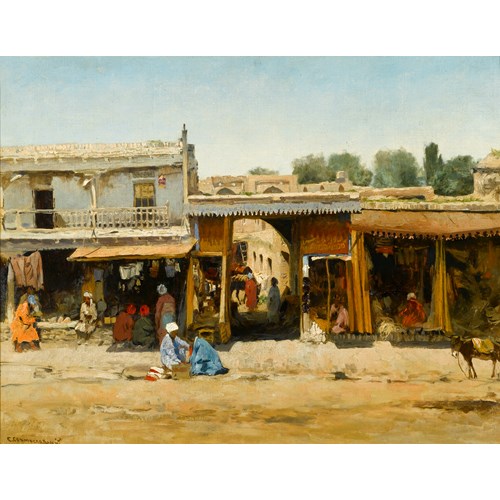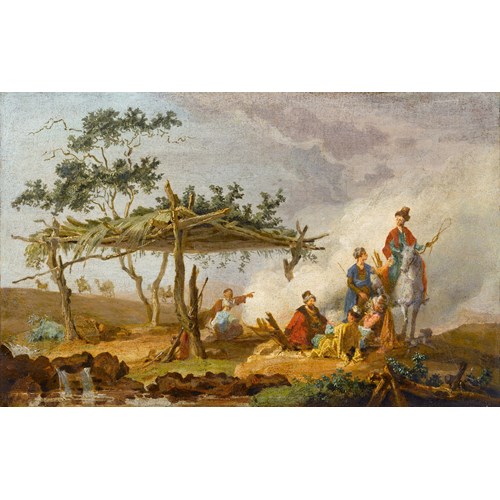Jacob Cats
A Swineherd with Three Pigs on a Track, a Windmill Beyond & A Peasant Watering his Animals at a Ford
Date 1772
Epoque 1750-1850, 18th century
Origine The Netherlands
Medium Black chalk, Pen, Grey and brown ink
Dimension 16.2 x 21.3 cm (6³/₈ x 8³/₈ inches)
The first of these representations of pastoral harmony, A Swineherd with Three Pigs on a Track, a Windmill Beyond, depicts an unmistakably Dutch landscape with a windmill, gnarled oak trees, thatched cottage and a peasant herding his pigs along a well-kept path. Cats’ expert ability in capturing the appearance of the sun-dappled leaves of the trees and the texture and tonality of the scene is evident. A drawing executed three years prior to the present one, Landscape with Cottage and Figures at the Side of a Road, in the Courtauld Gallery, London, depicts similarly engaging compositional elements and a concern with spatial depth and the effects of light and shade.
The second of the two drawings, A Peasant Watering his Animals at a Ford, is equally expressive in its depiction of a hillier and wilder landscape with rugged rocky outcrops. Another version of the work is housed in the Fogg Museum at Harvard. The two drawings, while strikingly similar, also bear perceptible differences. The present one appears heavier and more confident in its use of line and shading then the Harvard version. Details such as the shadowing on the path, the delineation of the foliage on the trees and the positioning of the animals in relation to the landscape differ between the two images, although Cats’ ability to imitate his own work is impressive. Cats is known to have been amenable to reworking past compositions as he is believed to have presented clients with a sample book of his drawings, from which they could choose their favourite subjects, motifs or whole compositions for him to replicate.¹ The works in his existing sample books are numbered on the verso in the artist’s hand and the Harvard drawing bears such a number. Perhaps, therefore, it was executed first, and a client who liked the result then commissioned A Peasant Watering his Animals at a Ford.
Cats, the son of the Dutch book dealer Johannes Cats, was trained as a bookbinder and engraver. He studied first under Abraham Starre, then with Pieter Louw (d.1800), and finally with the pattern designer Gerard van Rossum (c.1690-1772). For three years following, he became a wallpaper painter in the Amsterdam factory of Jan Hendrik Troost van Groenendoelen. At the age of twenty-one, Cats established his own business painting wall-hangings, and was considerably successful until the fashion began to decline. He then took up drawing, specialising in topographical views and landscapes, and also began executing copies of famous paintings by artists such as Rembrandt (1606-1669) and Gerrit Dou (1613-1675). Cats’ drawings were reproduced in prints by some of his contemporaries such as Isaac Jansz. de Wit (1744-1809), Cornelis Ploos van Amstel (1726-1798) and Jan Evert Grave (1759-1805).
16.2 x 21.3 cm (6⅜ x 8⅜ in); 17.6 x 24.5 cm (6⅞ x 9⅝ in)
¹ Turner, J.S., ‘Jacob Cats and the Identification of a “Pseudo-Goll van Franckenstein” Numbering System’, in Master Drawings, XXVIII, no. 3 (Autumn 1990), pp. 323-331.
Date: 1772
Epoque: 1750-1850, 18th century
Origine: The Netherlands
Medium: Black chalk, Pen, Grey and brown ink
Signature: Signed, dated and inscribed 'Bij Heemskerk J: Cats Ao 1772' (verso, 1).
Dimension: 16.2 x 21.3 cm (6³/₈ x 8³/₈ inches)
Provenance: Colonel H.A. Clowes; Christie's, London, 17 February 1950, lot 3 (to Clowes) and by descent
Plus d'œuvres d'art de la Galerie









